TOYOTA PRIUS PLUG-IN HYBRID 2015 1.G Quick Reference Guide
Manufacturer: TOYOTA, Model Year: 2015, Model line: PRIUS PLUG-IN HYBRID, Model: TOYOTA PRIUS PLUG-IN HYBRID 2015 1.GPages: 21, PDF Size: 1.68 MB
Page 11 of 21
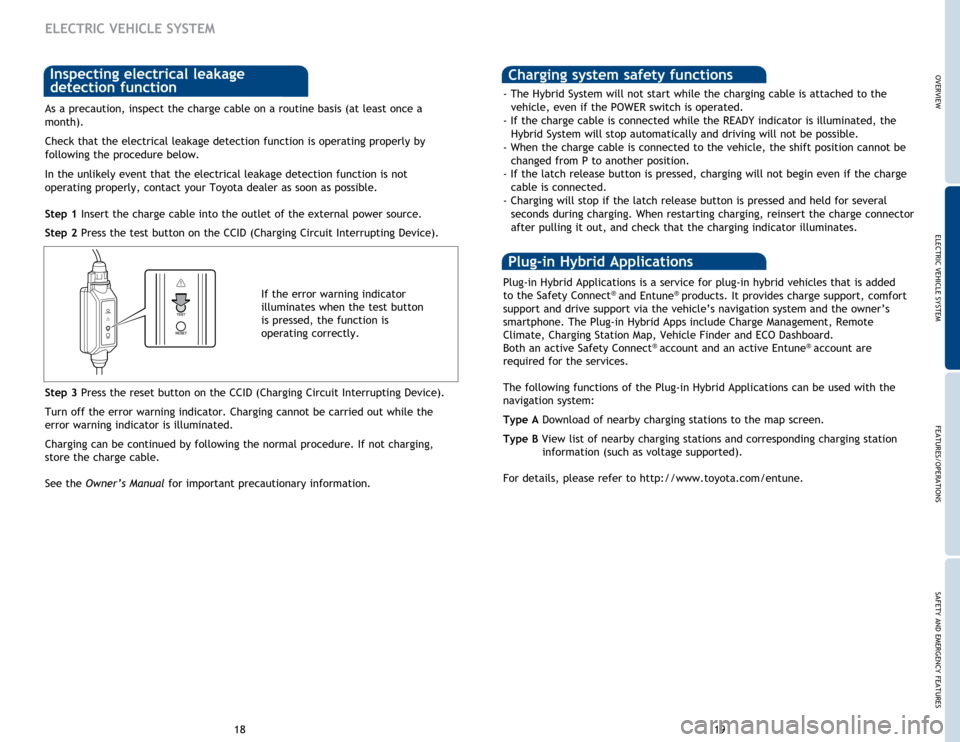
19
18
As a precaution, inspect the charge cable on a routine basis (at least once a
month).
Check that the electrical leakage detection function is operating properly by
following the procedure below.
In the unlikely event that the electrical leakage detection function is not
operating properly, contact your Toyota dealer as soon as possible.
Step 1 Insert the charge cable into the outlet of the external power source.
Step 2 Press the test button on the CCID (Charging Circuit Interrupting Device).
If the error warning indicator
illuminates when the test button
is pressed, the function is
operating correctly.
Step 3 Press the reset button on the CCID (Charging Circuit Interrupting Device).
Turn off the error warning indicator. Charging cannot be carried out while the
error warning indicator is illuminated.
Charging can be continued by following the normal procedure. If not charging,
store the charge cable.
See the Owner’s Manual for important precautionary information.
Inspecting electrical leakage
detection function
ELECTRIC VEHICLE SYSTEM
Charging system safety functions
- The Hybrid System will not start while the charging cable is attached to the
vehicle, even if the POWER switch is operated.
- If the charge cable is connected while the READY indicator is illuminated, the Hybrid System will stop automatically and driving will not be possible.
- When the charge cable is connected to the vehicle, the shift position cannot be changed from P to another position.
- If the latch release button is pressed, charging will not begin even if the charge cable is connected.
- Charging will stop if the latch release button is pressed and held for several seconds during charging. When restarting charging, reinsert the charge connector
after pulling it out, and check that the charging indicator illuminates.
Plug-in Hybrid Applications is a service for plug-in hybrid vehicles that is added
to the Safety Connect® and Entune® products. It provides charge support, comfort
support and drive support via the vehicle’s navigation system and the owner’s
smartphone. The Plug-in Hybrid Apps include Charge Management, Remote
Climate, Charging Station Map, Vehicle Finder and ECO Dashboard.
Both an active Safety Connect
® account and an active Entune® account are
required for the services.
The following functions of the Plug-in Hybrid Applications can be used with the
navigation system:
Type A Download of nearby charging stations to the map screen.
Type B View list of nearby charging stations and corresponding charging station information (such as voltage supported).
For details, please refer to http://www.toyota.com/entune.
Plug-in Hybrid Applications
OVERVIEWELECTRIC VEHICLE SYSTEM FEATURES/OPERATIONS
SAFETY AND EMERGENCY FEATURES
Page 12 of 21
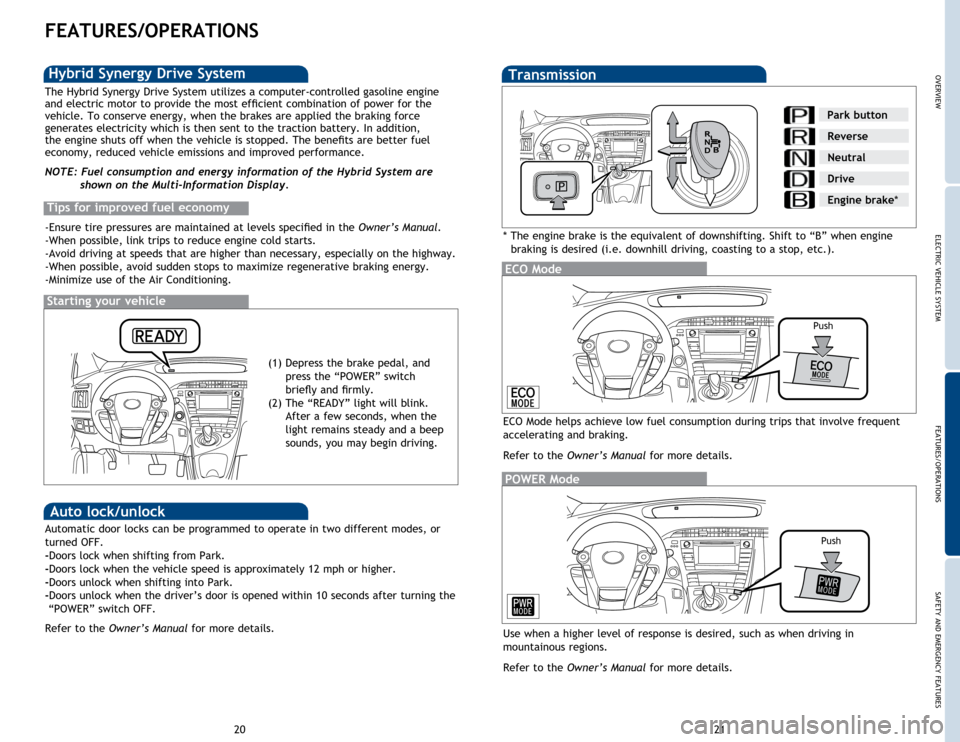
21
20
Transmission
*
The engine brake is the equivalent of downshifting. Shift to “B” when engine
braking is desired (i.e. downhill driving, coasting to a stop, etc.).
ECO Mode
Push
ECO Mode helps achieve low fuel consumption during trips that involve frequent
accelerating and braking.
Refer to the Owner’s Manual for more details.
Park button
Reverse
Neutral
Drive
Engine brake*
POWER Mode
Use when a higher level of response is desired, such as when driving in
mountainous regions.
Refer to the Owner’s Manual for more details.
Push
FEATURES/OPERATIONS
Starting your vehicle
The Hybrid Synergy Drive System utilizes a computer-controlled gasoline engine
and electric motor to provide the most efficient combination of power for the
vehicle. To conserve energy, when the brakes are applied the braking force
generates electricity which is then sent to the traction battery. In addition,
the engine shuts off when the vehicle is stopped. The benefits are better fuel
economy, reduced vehicle emissions and improved performance.
NOTE: Fuel consumption and energy information of the Hybrid System are
shown on the Multi-Information Display.
Tips for improved fuel economy
-Ensure tire pressures are maintained at levels specified in the Owner’s Manual.
-When possible, link trips to reduce engine cold starts.
-Avoid driving at speeds that are higher than necessary, especially on the highway.
-When possible, avoid sudden stops to maximize regenerative braking energy.
-Minimize use of the Air Conditioning.
Hybrid Synergy Drive System
Auto lock/unlock
Automatic door locks can be programmed to operate in two different modes, or
turned OFF.
-Doors lock when shifting from Park.
-Doors lock when the vehicle speed is approximately 12 mph or higher.
-Doors unlock when shifting into Park.
-Doors unlock when the driver’s door is opened within 10 seconds after turning the
“POWER” switch OFF.
Refer to the Owner’s Manual for more details. (1) Depress the brake pedal, and
press the “POWER” switch
briefly and firmly.
(2) The “READY” light will blink. After a few seconds, when the
light remains steady and a beep
sounds, you may begin driving.
OVERVIEWELECTRIC VEHICLE SYSTEM FEATURES/OPERATIONS
SAFETY AND EMERGENCY FEATURES
Page 13 of 21
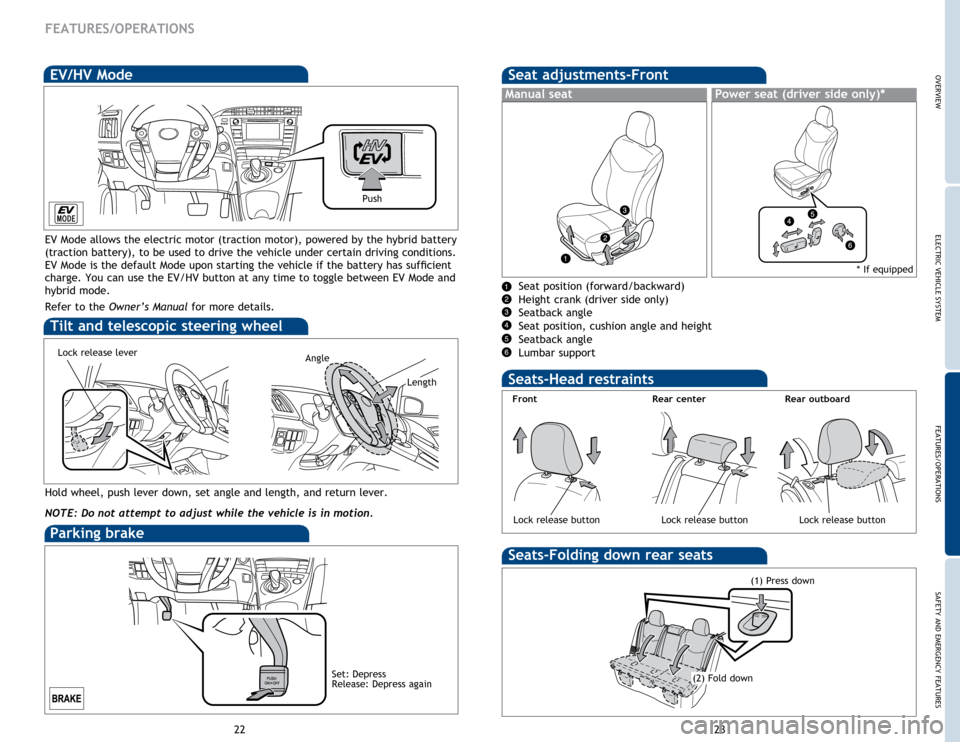
23
22
FEATURES/OPERATIONS
Seat adjustments-Front
Seats-Head restraints
Front Rear center
Lock release buttonLock release button
Rear outboard
Lock release button
(2) Fold down(1) Press down
Seats-Folding down rear seats
Seat position (forward/backward)
Height crank (driver side only)
Seatback
angle
Seat position, cushion angle and height
Seatback angle
Lumbar support
Manual seatPower seat (driver side only)*
* If equipped
Hold wheel, push lever down, set angle and length, and return lever.
NOTE: Do not attempt to adjust while the vehicle is in motion.
Tilt and telescopic steering wheel
EV/HV Mode
EV Mode allows the electric motor (traction motor), powered by the hybrid battery
(traction battery), to be used to drive the vehicle under certain driving conditions.
EV Mode is the default Mode upon starting the vehicle if the battery has sufficient
charge. You can use the EV/HV button at any time to toggle between EV Mode and
hybrid mode.
Refer to the Owner’s Manual for more details.
Push
Angle
Length
Lock release lever
Parking brake
Set: Depress
Release: Depress again
OVERVIEWELECTRIC VEHICLE SYSTEM FEATURES/OPERATIONS
SAFETY AND EMERGENCY FEATURES
Page 14 of 21
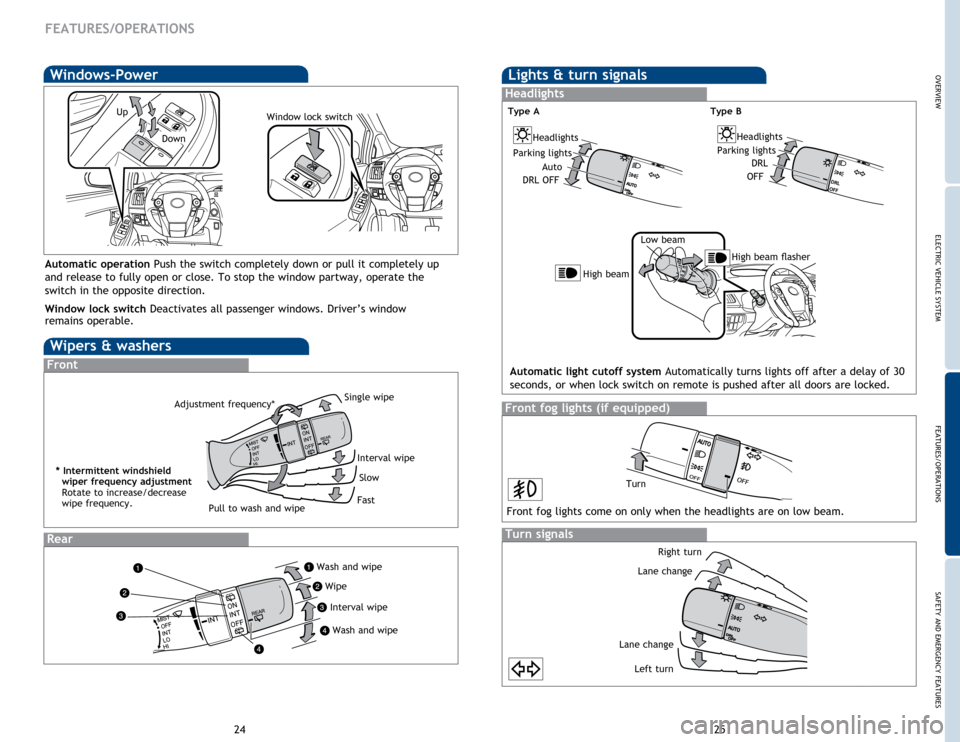
25
24
FEATURES/OPERATIONS
Lights & turn signals
Turn signals
Headlights
High beam flasher
Low beam
Front fog lights (if equipped)
Automatic light cutoff system Automatically turns lights off after a delay of 30
seconds, or when lock switch on remote is pushed after all doors are locked.
Front fog lights come on only when the headlights are on low beam.
Right turn
Lane change
Lane change Left turn
High beam
Auto
Parking lights
Turn
Headlights
DRL OFF
Parking lights
Headlights
OFF
Type A
Type B
DRL
Wipers & washers
Interval wipe
Single wipe
Slow
Fast
Pull to wash and wipe
Front
Rear
Windows-Power
Up
Down
Window lock switch
Automatic operation Push the switch completely down or pull it completely up
and release to fully open or close. To stop the window partway, operate the
switch in the opposite direction.
Window lock switch Deactivates all passenger windows. Driver’s window
remains operable.
Wash and wipe
Wipe
Interval wipe
Wash and wipe
Adjustment frequency*
* Intermittent windshield
wiper frequency adjustment
Rotate to increase/decrease
wipe frequency.
OVERVIEWELECTRIC VEHICLE SYSTEM FEATURES/OPERATIONS
SAFETY AND EMERGENCY FEATURES
Page 15 of 21
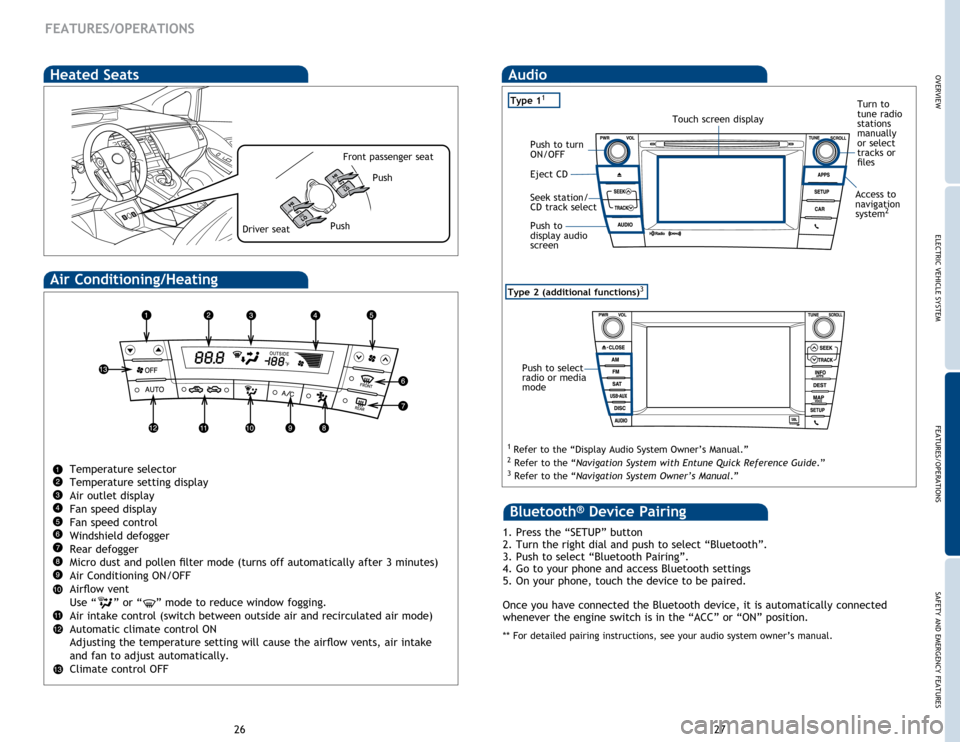
27
26
FEATURES/OPERATIONS
Type 2 (additional functions)3
Audio
1 Refer to the “Display Audio System Owner’s Manual.” 2
Refer to the “Navigation System with Entune Quick Reference Guide.”
3 Refer to the “Navigation System Owner’s Manual .”
Push to select
radio or media
mode
Eject CD Push to turn
ON/OFF
Seek station/
CD track select
Push to
display audio
screenTouch screen display
Type 11 Turn to
tune radio
stations
manually
or select
tracks or
files
Access to
navigation
system
2
Air Conditioning/Heating
Temperature selector
Temperature setting display
Air outlet display
Fan speed display
Fan speed control
Windshield defogger
Rear defogger
Micro dust and pollen filter mode (turns off automatically after 3 minutes)
Air Conditioning ON/OFF
Airflow vent
Use “
” or “” mode to reduce window fogging.
Air intake control (switch between outside air and recirculated air mode)
Automatic climate control ON
Adjusting the temperature setting will cause the airflow vents, air intake
and fan to adjust automatically.
Climate control OFF
Heated Seats
Push
Push
Driver seat
Front passenger seat
1. Press the “SETUP” button
2. Turn the right dial and push to select “Bluetooth”.
3. Push to select “Bluetooth Pairing”.
4. Go to your phone and access Bluetooth settings
5. On your phone, touch the device to be paired.
Once you have connected the Bluetooth device, it is automatically connected
whenever the engine switch is in the “ACC” or “ON” position.
** For detailed pairing instructions, see your audio system owner’s manual.
Bluetooth® Device Pairing
OVERVIEWELECTRIC VEHICLE SYSTEM FEATURES/OPERATIONS
SAFETY AND EMERGENCY FEATURES
Page 16 of 21
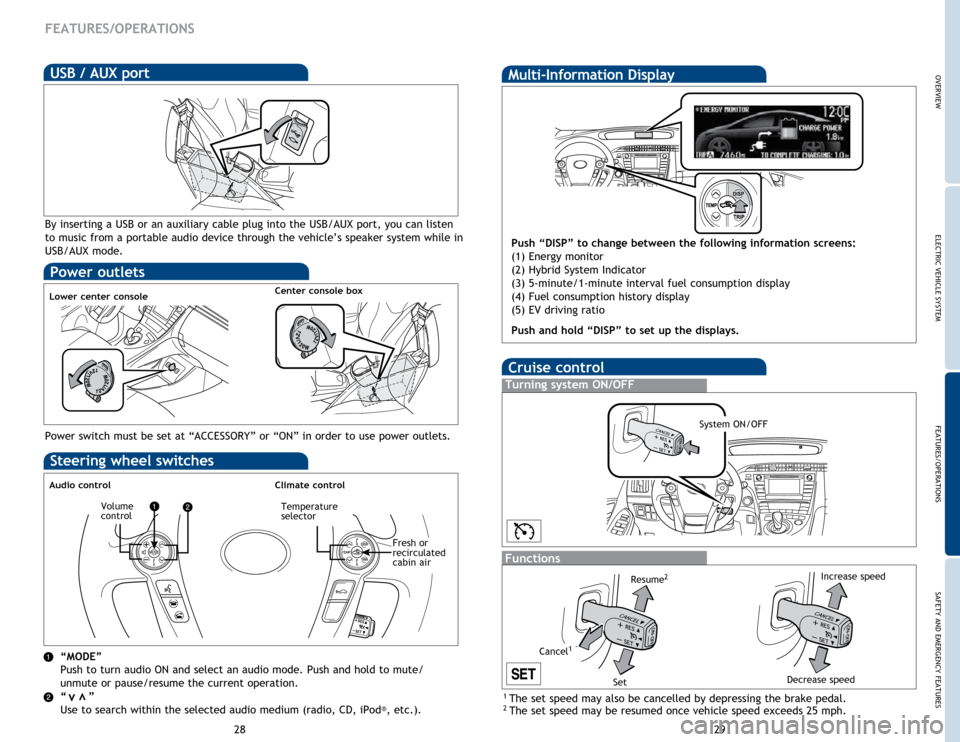
29
28
Cruise control
1 The set speed may also be cancelled by depressing the brake pedal.2 The set speed may be resumed once vehicle speed exceeds 25 mph.
Turning system ON/OFF
Functions
System ON/OFF
Increase speed
Decrease speed
Cancel1
Resume2
Set
FEATURES/OPERATIONS
Multi-Information Display
Push “DISP” to change between the following information screens:
(1) Energy monitor
(2) Hybrid System Indicator
(3) 5-minute/1-minute interval fuel consumption display
(4) Fuel consumption history display
(5) EV driving ratio
Push and hold “DISP”
to set up the displays.
Power outlets
Lower center console Center console box
Power switch must be set at “ACCESSORY” or “ON” in order to use power outlets.
Steering wheel switches
Audio controlClimate control
“MODE”
Push to turn audio ON and select an audio mode. Push and hold to mute/
unmute or pause/resume the current operation.
“ ”
Use to search within the selected audio medium (radio, CD, iPod
®, etc.).
vv
Volume
controlTemperature
selector
Fresh or
recirculated
cabin air
By inserting a USB or an auxiliary cable plug into the USB/AUX port, you can listen
to music from a portable audio device through the vehicle’s speaker system while in
USB/AUX mode.
USB / AUX port
OVERVIEWELECTRIC VEHICLE SYSTEM FEATURES/OPERATIONS
SAFETY AND EMERGENCY FEATURES
Page 17 of 21
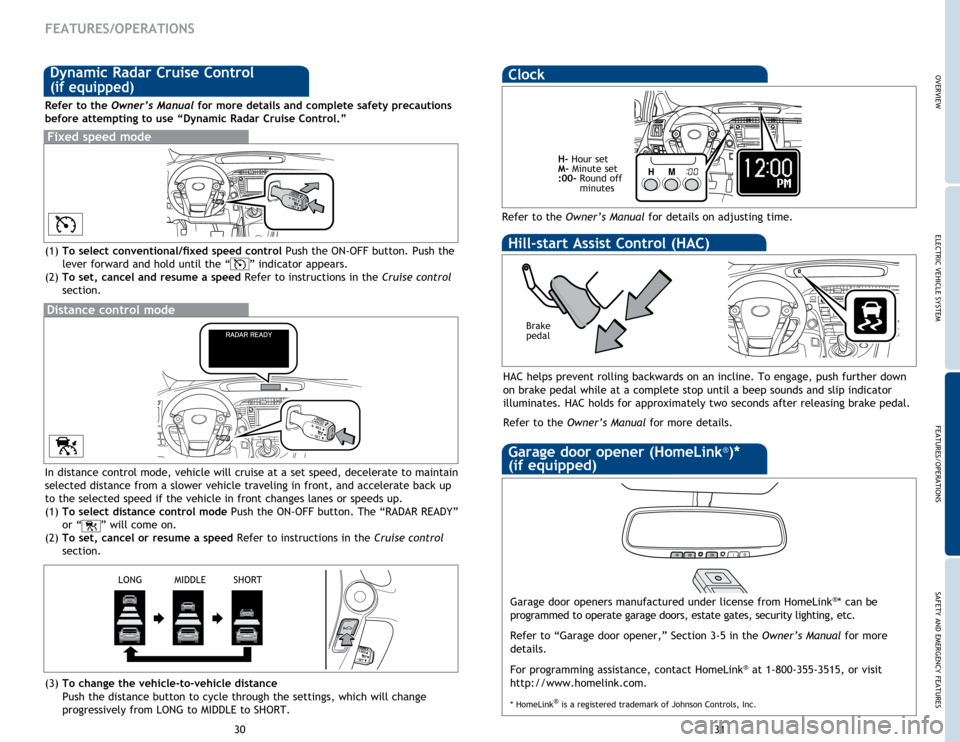
31
30
FEATURES/OPERATIONS
Clock
Refer to the Owner’s Manual for details on adjusting time.
H- Hour set
M- Minute set
:00- Round off
minutes
HAC helps prevent rolling backwards on an incline. To engage, push further down
on brake pedal while at a complete stop until a beep sounds and slip indicator
illuminates. HAC holds for approximately two seconds after releasing brake pedal.
Refer to the Owner’s Manual for more details.
Brake
pedal
Hill-start Assist Control (HAC)
Garage door openers manufactured under license from HomeLink®* can be
programmed to operate garage doors, estate gates, security lighting, etc\
.
Refer to “Garage door opener,” Section 3-5 in the Owner’s Manual for more
details.
For programming assistance, contact HomeLink
® at 1-800-355-3515, or visit
http://www.homelink.com.
* HomeLink® is a registered trademark of Johnson Controls, Inc.
Garage door opener (HomeLink®)*
(if equipped)
(1) To select conventional/fixed speed control Push the ON-OFF button. Push the
lever forward and hold until the “
” indicator appears.
(2) To set, cancel and resume a speed Refer to instructions in the Cruise control
section.
Fixed speed mode
Refer to the Owner’s Manual for more details and complete safety precautions
before attempting to use “Dynamic Radar Cruise Control.”
Dynamic Radar Cruise Control
(if equipped)
In distance control mode, vehicle will cruise at a set speed, decelerate to maintain
selected distance from a slower vehicle traveling in front, and accelerate back up
to the selected speed if the vehicle in front changes lanes or speeds up.
(1) To select distance control mode Push the ON-OFF button. The “RADAR READY”
or “
” will come on.
(2) To set, cancel or resume a speed Refer to instructions in the Cruise control
section.
(3) To change the vehicle-to-vehicle distance
Push the distance button to cycle through the settings, which will change
progressively from LONG to MIDDLE to SHORT.
Distance control mode
LONG MIDDLE SHORT
OVERVIEWELECTRIC VEHICLE SYSTEM FEATURES/OPERATIONS
SAFETY AND EMERGENCY FEATURES
Page 18 of 21
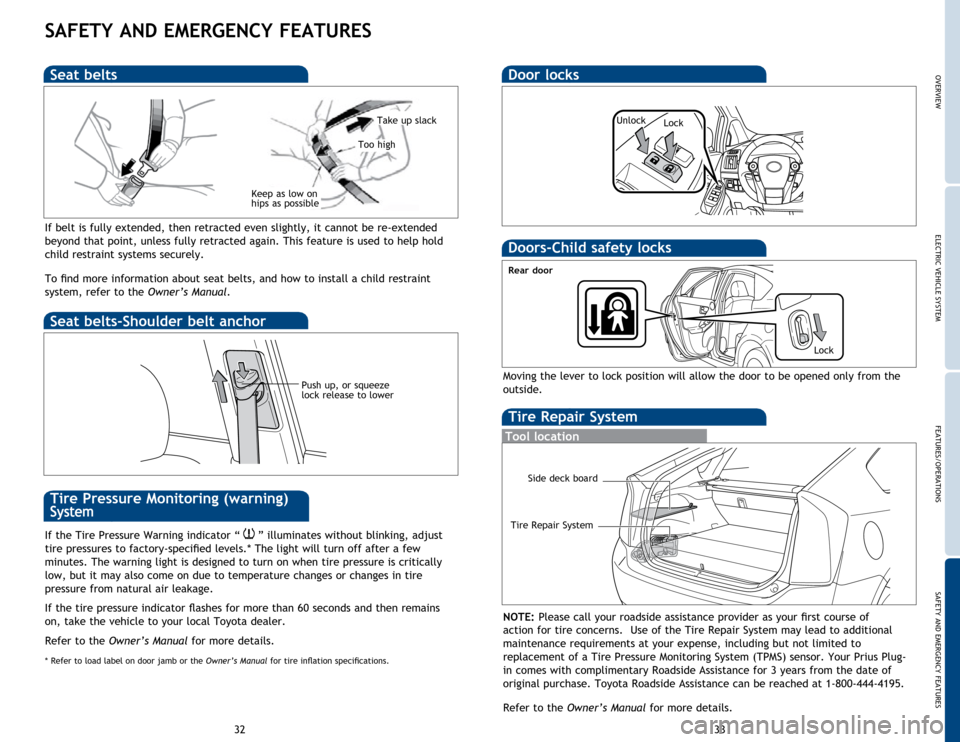
33
32
SAFETY AND EMERGENCY FEATURES
If belt is fully extended, then retracted even slightly, it cannot be re-extended
beyond that point, unless fully retracted again. This feature is used to help hold
child restraint systems securely.
To find more information about seat belts, and how to install a child restraint
system, refer to the Owner’s Manual.
Keep as low on
hips as possible
Take up slack
Too high
Seat belts
Push up, or squeeze
lock release to lower
Seat belts-Shoulder belt anchor
Door locks
If the Tire Pressure Warning indicator “” illuminates without blinking, adjust
tire pressures to factory-specified levels.* The light will turn off after a few
minutes. The warning light is designed to turn on when tire pressure is critically
low, but it may also come on due to temperature changes or changes in tire
pressure from natural air leakage.
If the tire pressure indicator flashes for more than 60 seconds and then remains
on, take the vehicle to your local Toyota dealer.
Refer to the Owner’s Manual for more details.
* Refer to load label on door jamb or the Owner’s Manual for tire inflation specifications.
Tire Pressure Monitoring (warning)
System
Tire Repair System
Tool location
NOTE: Please call your roadside assistance provider as your first course of
action for tire concerns. Use of the Tire Repair System may lead to additional
maintenance requirements at your expense, including but not limited to
replacement of a Tire Pressure Monitoring System (TPMS) sensor. Your Prius Plug-
in comes with complimentary Roadside Assistance for 3 years from the date of
original purchase. Toyota Roadside Assistance can be reached at 1-800-444-4195.
Refer to the Owner’s Manual for more details.
Tire Repair System
Moving the lever to lock position will allow the door to be opened only from the
outside.
Rear door
Doors-Child safety locks
Unlock
Side deck board Lock
Lock
OVERVIEWELECTRIC VEHICLE SYSTEM FEATURES/OPERATIONS
SAFETY AND EMERGENCY FEATURES
Page 19 of 21
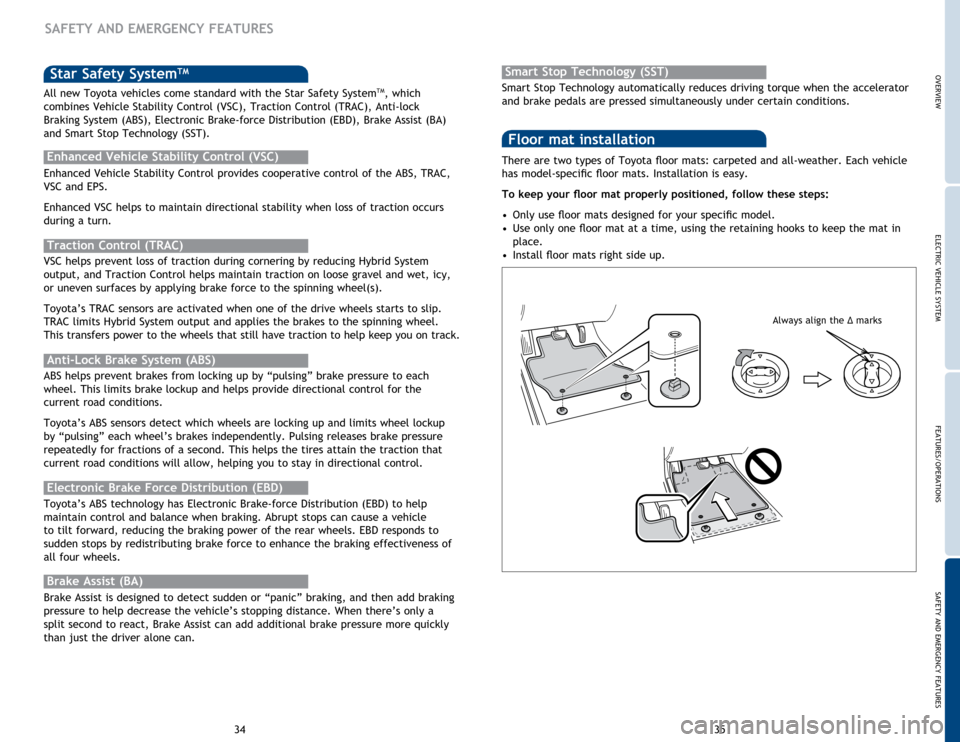
35
34
Star Safety SystemTM
Enhanced Vehicle Stability Control provides cooperative control of the ABS, TRAC,
VSC and EPS.
Enhanced VSC helps to maintain directional stability when loss of traction occurs
during a turn.
Enhanced Vehicle Stability Control (VSC)
Anti-Lock Brake System (ABS)
ABS helps prevent brakes from locking up by “pulsing” brake pressure to each
wheel. This limits brake lockup and helps provide directional control for the
current road conditions.
Toyota’s ABS sensors detect which wheels are locking up and limits wheel lockup
by “pulsing” each wheel’s brakes independently. Pulsing releases brake pressure
repeatedly for fractions of a second. This helps the tires attain the traction that
current road conditions will allow, helping you to stay in directional control.
Brake Assist (BA)
Brake Assist is designed to detect sudden or “panic” braking, and then add braking
pressure to help decrease the vehicle’s stopping distance. When there’s only a
split second to react, Brake Assist can add additional brake pressure more quickly
than just the driver alone can. VSC helps prevent loss of traction during cornering by reducing Hybrid System
output, and Traction Control helps maintain traction on loose gravel and wet, icy,
or uneven surfaces by applying brake force to the spinning wheel(s).
Toyota’s TRAC sensors are activated when one of the drive wheels starts to slip.
TRAC limits Hybrid System output and applies the brakes to the spinning wheel.
This transfers power to the wheels that still have traction to help keep\
you on track.
Traction Control (TRAC)
Electronic Brake Force Distribution (EBD)
Toyota’s ABS technology has Electronic Brake-force Distribution (EBD) to help
maintain control and balance when braking. Abrupt stops can cause a vehicle
to tilt forward, reducing the braking power of the rear wheels. EBD responds to
sudden stops by redistributing brake force to enhance the braking effectiveness of
all four wheels.
SAFETY AND EMERGENCY FEATURES
All new Toyota vehicles come standard with the Star Safety SystemTM, which
combines Vehicle Stability Control (VSC), Traction Control (TRAC), Anti-lock
Braking System (ABS), Electronic Brake-force Distribution (EBD), Brake Assist (BA)
and Smart Stop Technology (SST).
There are two types of Toyota floor mats: carpeted and all-weather. Each vehicle
has model-specific floor mats. Installation is easy.
To keep your floor mat properly positioned, follow these steps:
•
Only
use floor mats designed for your specific model.
•
Use
only one floor mat at a time, using the retaining hooks to keep the mat in
place.
•
Install
floor mats right side up.
Floor mat installation
Smart Stop Technology automatically reduces driving torque when the accelerator
and brake pedals are pressed simultaneously under certain conditions.
Smart Stop Technology (SST)
Always align the Δ marks
OVERVIEWELECTRIC VEHICLE SYSTEM FEATURES/OPERATIONS
SAFETY AND EMERGENCY FEATURES
Page 20 of 21

37
36
NOTES
OVERVIEWELECTRIC VEHICLE SYSTEM FEATURES/OPERATIONS
SAFETY AND EMERGENCY FEATURES